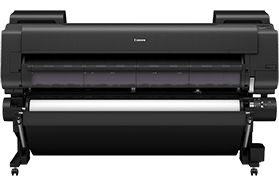Explore null | Canon Latin America

imagePROGRAF GP-6600S
-
OVERVIEW
-
SPECIFICATIONS
-
ACCESSORIES
-
RESOURCES
-
SUPPORT
-
MISCELLANEOUS
Production Redefined
- Excellent color accuracy
- Large color gamut, particularly in dark areas
- Superb scratch resistance
- Excellent light-resistant pigment ink to help improve ink longevity
- Orange and Matte Black from the imagePROGRAF GP-4000/2000 helps enhance vivid eye-catching prints
- 96% of PANTONE™ Formula Guide Solid and Coated*
Produces vivid color prints with more accurate color reproduction and improved black density color output than predecessor models.
- High scratch resistance
- High light resistance for longer term preservation of prints
- Fast print speeds with L-COA PRO Processor
The ability to calibrate the printer for consistent color, this helps ensure the output is color consistent over time and across multiple imagePROGRAF GP S Series devices.
- Intelligent media handling helps reduce time and waste
- Automatic media feeding
- Automatic media type, width, and length detection
- Reduced media feed processing time from previous imagePROGRAF PRO S Series models
- Multifunction Roll Unit
- Standard with the imagePROGRAF GP-6600S
- Optional for the imagePROGRAF GP-4600S
- The user interface screen displays the ink levels, media indicator levels, and other setting prompts all on the home screen
- Easily see ink tanks and loaded media through translucent covers
- Interior LED light for reliable operation, such as previewing output while printing
- Hot-swap ink tanks
- EPEAT® Gold
- ENERGY STAR®
Professional Print and Layout enables easy professional photo printing with editing and layout tools, as well as color management capabilities.
Free Layout Plus lets you nest, tile, and create custom layouts before printing your files with this print utility.
Accounting Manager helps track actual ink and media usage and costs.
- Windows Server 2025
- macOS 15
- macOS 14
- macOS 13
- Windows 11
- macOS 12
- Windows Server 2022
- macOS 11
- Linux MIPS
- Linux ARM
- macOS 11.0
- macOS 10.15
- macOS v10.13
- macOS v10.14
- Windows Server 2019 (x64)
- macOS v10.14
- macOS v10.13
- Windows Server 2016 (x64)
- macOS v10.12
- Linux 64bit
- Linux 32bit
- OS X v10.11
- Windows 10
- Windows 10 (x64)
- OS X v10.10
- Windows Server 2012 R2 (x64)
- OS X v10.9
- Windows 8.1 (x64)
- Windows 8.1
- Windows Server 2012 (x64)
- Windows 8
- Windows 8 (x64)
- Windows 7
- Windows 7 (x64)
- Windows Vista
- Windows Vista (x64)
- Windows XP
- Windows XP (x64)
- Windows Server 2008
- Windows Server 2008 (x64)
- Windows Server 2008 R2 (x64)
- Windows Server 2003
- Windows Server 2003 (x64)
- Windows Server 2003 R2
- Windows Server 2003 R2 (x64)
- Windows 2000
- Windows NT
- Windows 3.1
- Windows Me
- Windows 98
- Windows 95
- Mac OS X v10.8
- Mac OS X v10.7
- Mac OS X v10.6
- Mac OS X v10.5
- Mac OS X v10.4
- Mac OS X v10.3
- Mac OS X v10.2
- Mac OS X v10.1
- Mac OS X
- Mac OS 9
- Mac OS 8
- Linux (x64)
- Linux (x32)
- Linux
- Not Applicable
Locating and Installing Your Download Cómo Localizar e Instalar su Descarga Localizando e Instalando seu Download
How to identify your OS version
To help determine which Windows operating system is running on your computer, please view the below steps:
Windows 11
Click on the Windows button (located left to the Search at the bottom).
Click on the Settings button to navigate to the system settings.
Scroll to the bottom of the page and click on the About button.
You will be able to find your Windows operating system under the Windows Specifications section.
Windows® 10
Click Start or click the Windows button (usually found in the lower-left corner of your screen).
Click Settings.
Click About (which is usually located within the lower left of the screen). The next screen should display the Windows version.
Windows 8 or Windows 8.1
Option1: Swipe in from the upper-right corner of the screen while viewing the desktop in order to open the menu, then select Settings.
Select PC Info. Under Windows edition, the Windows version is shown.
Option 2: From the Start Screen
While on the Start screen, type computer.
Right-click on the computer icon. If using touch, press and hold on the computer icon.
Click or tap Properties. Under Windows edition, the Windows version is shown.
Windows 7
Click Start or click the Windows button (usually found in the lower-left corner of your screen).
Right-click Computer and select Properties from the menu. The resulting screen should now display the Windows version.
Linux
To check the version of your Linux operating system (OS), you can use the following commands in your terminal:
1. uname -r: Displays your Linux kernel version.
2. cat /etc/os-release: Displays your distribution name and version.
3. lsb_release -a: Displays specific details about your Linux distribution and version.
4. You can also use the hostnamectl command to display the Linux kernel version. However, this command is only available on Linux distributions that use systemd by default.
To help determine which Mac operating system is running on your computer, select the Apple menu in the upper-left corner of your screen and choose About This Mac.
Upon selecting, you should see the macOS name followed by the version number.
Canon U.S.A Inc. All Rights Reserved. Reproduction in whole or part without permission is prohibited.